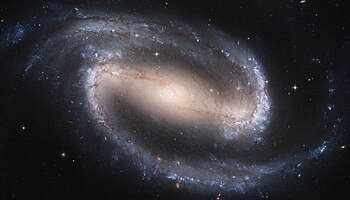NGC 1300
| NGC 1300 | |
|---|---|

|
|
| Observation data (J2000 epoch) | |
| Constellation | Eridanus |
| Right ascension | 03h 19m 41.1s |
| Declination | −19° 24′ 41″ |
| Redshift | 0.005260 (1577 ± 4 km/s) |
| Distance | 61.3 Mly (18.8 Mpc) |
| Apparent magnitude (V) | 11.4 |
| Characteristics | |
| Type | (R')SB(s)bc |
| Size | 110,000 light years in diameter |
| Apparent size (V) | 6′.2 × 4′.1 |
| Notable features | Huge bar-shaped core and two spiral arms |
| Other designations | |
| MCG-03-09-018, ESO 547 -G 31, PGC 12412 |
|
NGC 1300 is a barred spiral galaxy about 61 million light-years away in the constellation Eridanus. The galaxy is about 110,000 light-years across (about 2/3 the size of the Milky Way). It is a member of the Eridanus Cluster, a cluster of 200 galaxies. It was discovered by John Herschel in 1835.
In the core of the larger spiral structure of NGC 1300, the nucleus shows a "grand-design" spiral structure that is about 3,300 light-years long. Only galaxies with large-scale bars appear to have these grand-design inner disks — a spiral within a spiral. Models suggest that the gas in a bar can be funneled inwards, and then spiral into the center through the grand-design disk, where it can potentially fuel a central black hole. NGC 1300 is not known to have an active nucleus, indicating that its central black hole is not accreting matter.
...
Wikipedia
